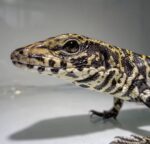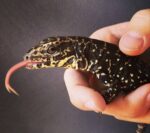Description
he gold tegu, also known as the golden tegu, common tegu, black tegu, Colombian black and white tegu and tiger lizard (in Trinidad), is a species of tegu.
Taxonomy of Colombian Tegu For Sale
Its old scientific name (synonym) was Tupinambis nigropunctatus, but it has since renamed to Tupinambis teguixin.
Description of Colombian Tegu For Sale
Gold tegus grow to be about 2 to 3 ft (60 to 100 cm) long on average, and up to 3.5 to 4.0 kg in weight, with a glossy body, powerful limbs and a thick tail. They have many black and gold stripes down their bodies.
-
In Ecuador
Distribution of Colombian Tegu For Sale
Gold tegus live in the tropical forests of northern and central South America, as well as in Panama. Its South American range extends to the island of Trinidad.

Diet of Colombian Tegu For Sale
They feed on insects, other invertebrates (such as snails), small mammals, other reptiles (such as smaller lizards and small snakes), birds, and fish; it takes nest eggs of birds, turtles, and caimans. It sometimes eats fruit and honey.
Colombian Tegu For Sale As pets
They typically do not make as good a pet as their larger southern relatives, the Argentine black and white tegu and the red tegu; however, if handled frequently, they can make a good pet.
Description of Colombian Tegu For Sale
Tegus are, usually, black mixed with other colors and patterns; some have yellow, reddish or white bands along their backs, others have lines going down their bodies with unique markings on their sides. Their body shape is aerodynamic with long tails and strong legs. Most tegus grow to about a metre long, but the black and white tegu (S. merianae) can grow to about 1.3 metres.
Although, in appearance, tegus resemble the Varanidae (monitors), they are not closely related to them. Their initial similarities are an example of convergent evolution, when unrelated or distantly-related species develop physical or behavioral similarities based on ecological niche, adaptations or environment.
Tegus use their tongues and vomeronasal organ to find chemical cues associated with their prey and other lizards. A vomeronasal organ is an organ of chemoreception located in the nasal chamber.
Habitat of Colombian Tegu For Sale
Tegus naturally occur in rainforests, deciduous semiarid thorn forests, savannas, fields and grasslands. They have also adapted to open areas created by agriculture, parks and construction zones. They spend much of their time in burrows.
Diet
As omnivores, tegus feed on various foods including fruits, insects, frogs, small rodents, birds, eggs and carrion. Tegus living near humans may raid chicken coops for eggs and baby chicks, or scavenge leftover food such as crackers, cheese and chips.
Behaviour
When confronted, a wild tegu initially stops moving with its head held up high, then attempts to flee. It may turn aggressive if cornered, biting and attacking with its tail. In contrast, captive-raised tegus can be docile, intelligent and social with their carers.
Tegus are popular in the international pet trade as owner’s often compare them to dogs due to their loving, casual nature.
In the coolest areas of their range, such as northern Argentina, tegus hibernate from June to September.
Endothermy of Colombian gold Tegu For Sale
During the reproductive season, Argentine black and white tegus can raise their body temperature by up to 10 °C above the ambient temperature (seasonal reproductive endothermy). This may be advantageous when coming out of hibernation, regrowing gonads, producing gametes (gametogenesis), mating, and (for females) producing eggs and incubating them.
Importance of Colombian gold Tegu For Sale
Tegus are traditionally hunted for their meat, fat, and hides.
Argentine black and white tegus are widely and successfully bred and kept as pets, with red tegus being slightly less common in the hobby but still present. Additionally, Dracaena guianensis, the northern caiman lizard, is growing in popularity among breeders and hobbyists.


























Reviews
There are no reviews yet.